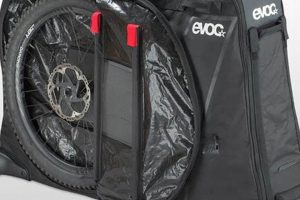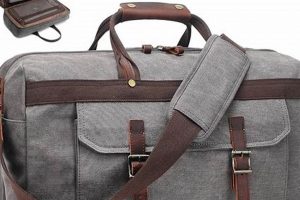Specifically designed luggage items offer enhanced security features to deter theft during transit. These products incorporate elements such as slash-resistant materials, locking zippers, and RFID-blocking technology to safeguard personal belongings. For example, a backpack constructed with interwoven steel mesh and equipped with a combination lock prevents unauthorized access to its contents.
The utilization of these secure travel containers provides a tangible sense of security and minimizes the risk of financial loss and inconvenience associated with theft. Historically, travelers have sought methods to protect their valuables; these enhanced luggage options represent a modern iteration of that enduring need, adapting to evolving security challenges in airports, train stations, and other public spaces.
Subsequent sections will delve into the specific security technologies integrated into these specialized luggage solutions, outlining criteria for evaluating their effectiveness and providing guidance on selecting the optimal product based on individual travel needs and risk assessments.
Protecting Valuables During Travel
The following outlines specific actions to mitigate the risk of theft when utilizing security-enhanced luggage during transit.
Tip 1: Investigate Material Composition: Prioritize luggage constructed from slash-resistant fabrics such as Dyneema or reinforced nylon. A demonstration of the fabric’s resistance to cutting tools should be provided by the manufacturer.
Tip 2: Examine Zipper Security Mechanisms: Luggage should feature locking zippers or tamper-evident closures. Zippers that can be secured to fixed points on the bag with a combination lock are preferable.
Tip 3: Assess Compartmentalization and Concealment: Internal compartments and hidden pockets can obscure valuable items. Distribute belongings to avoid attracting attention to a single area.
Tip 4: Verify RFID Blocking Capabilities: For safeguarding electronic credentials, ensure that the luggage incorporates RFID-blocking technology to prevent unauthorized scanning of passports and credit cards.
Tip 5: Consider Physical Security Accessories: Augment the luggage with cable locks or portable safes to secure it to stationary objects in transit or within accommodations.
Tip 6: Maintain Visual Contact or Secure Storage: Never leave luggage unattended in public areas. Utilize secure storage facilities at airports or train stations when necessary.
Tip 7: Document Valuables: Prior to departure, create a photographic record of valuable items and their serial numbers to facilitate insurance claims in the event of theft.
By adhering to these recommendations, individuals can significantly decrease their vulnerability to theft and ensure the safety of their possessions during travel.
The subsequent segment will focus on the economic aspects and insurance considerations related to utilizing enhanced security luggage.
1. Material Resistance
Material resistance forms a foundational component in the efficacy of theft-deterrent travel bags. The vulnerability of conventional luggage to slashing and forced entry necessitates the incorporation of robust materials capable of withstanding such attacks. The selection of materials exhibiting high tensile strength and cut resistance directly impacts the security level afforded by the bag. For example, bags constructed from tightly woven ballistic nylon, reinforced with embedded steel cables, provide a significant barrier against attempts to compromise the bag’s integrity using knives or other sharp implements. This resistance translates directly into a delayed or thwarted theft attempt, increasing the likelihood of detection or abandonment by the perpetrator.
The practical significance of material resistance extends beyond mere physical barriers. The presence of visibly robust materials can act as a deterrent, discouraging potential thieves from targeting the bag in the first instance. Furthermore, materials designed to withstand harsh conditions, such as abrasion-resistant coatings, contribute to the bag’s longevity and reduce the likelihood of compromising situations arising from wear and tear. Consider the case of a traveler navigating crowded public transport; a bag constructed from easily torn fabric is inherently more vulnerable than one utilizing a material specifically engineered for durability and resistance to forced entry.
In summary, material resistance is not merely a design feature but a fundamental requirement for luggage intended to provide a meaningful degree of theft deterrence. The selection of appropriate materials, coupled with thoughtful construction techniques, determines the bag’s ability to withstand attempted breaches and protect its contents. Ongoing advancements in material science continue to drive improvements in this area, presenting opportunities for manufacturers to enhance the security and peace of mind afforded to travelers.
2. Locking Mechanisms
Locking mechanisms represent a critical facet of luggage engineered for theft deterrence. The presence and sophistication of these mechanisms directly impact the bag’s capacity to resist unauthorized access. A secure locking system prevents opportunistic theft by impeding swift or surreptitious entry. For instance, a bag employing TSA-approved combination locks on all external zippers restricts access to individuals possessing the correct combination or a compatible master key used by security personnel. Conversely, a bag with easily bypassed zippers presents a significantly higher risk of theft, as demonstrated by cases where conventional zippers are opened with simple tools like pens.
The effectiveness of locking mechanisms is further enhanced when coupled with other security features. Slash-resistant materials, for example, complement the locking system by preventing access through the bag’s fabric. Integrated cable locks offer an additional layer of security by allowing the bag to be tethered to stationary objects, hindering its removal. A real-world application involves securing a backpack to a train seat during overnight travel, reducing the likelihood of theft while the traveler is asleep. The practical significance of this understanding lies in the ability to assess the comprehensive security offered by a particular bag, recognizing that locking mechanisms are but one element of a broader security strategy.
In summary, locking mechanisms are an indispensable component of theft-deterrent luggage, acting as a primary barrier against unauthorized access. The type, quality, and integration of these mechanisms significantly influence the bag’s overall security profile. A holistic evaluation of a bag’s security features, including locking mechanisms, material resistance, and tethering options, is essential for making informed decisions and mitigating the risk of theft during travel.
3. RFID Blocking
RFID (Radio-Frequency Identification) blocking technology is an increasingly crucial feature in security-focused travel bags, designed to mitigate electronic theft. Its integration addresses vulnerabilities associated with modern identification and payment methods, enhancing overall security for travelers.
- Data Skimming Prevention
RFID blocking materials embedded within the bag’s construction impede unauthorized scanning of RFID-enabled credit cards, passports, and identification documents. These materials create a Faraday cage effect, preventing radio waves from penetrating and accessing the data stored on RFID chips. A practical example is the prevention of a criminal using an RFID reader to wirelessly extract credit card details from a wallet within a bag in a crowded public space.
- Protection Against Identity Theft
By preventing RFID skimming, these bags reduce the risk of identity theft. Compromised personal information can be used for fraudulent activities, resulting in financial loss and other detrimental consequences. By safeguarding sensitive data, the technology offers a proactive defense against such threats. Consider a scenario where a passports RFID chip is scanned without consent, potentially leading to identity fraud on future travels; RFID blocking prevents this.
- Enhanced Security Layer
RFID blocking adds a supplementary layer of security to existing theft-deterrent features, such as locking zippers and slash-resistant materials. It addresses a different type of vulnerabilityelectronic rather than physical theftand complements other security measures to create a more comprehensive defense. For instance, even if a bag’s physical defenses are compromised, the RFID-blocking lining continues to protect against electronic data theft.
- Compliance with Security Standards
Many RFID-blocking products undergo testing and certification to ensure they meet specific performance standards. These certifications provide consumers with assurance regarding the product’s effectiveness. Compliance with standards demonstrates a commitment to providing verifiable protection against RFID skimming. The presence of certification marks adds credibility and reinforces consumer trust in the product’s capabilities.
In conclusion, the inclusion of RFID blocking technology in security-focused travel bags represents a proactive response to the evolving threat landscape. While physical security measures address traditional theft methods, RFID blocking specifically targets electronic vulnerabilities, providing travelers with enhanced protection against data skimming and identity theft, thus contributing to the overall integrity and effectiveness of “theft proof travel bags.”
4. Concealed Compartments
Concealed compartments within travel luggage offer a strategic advantage in deterring theft by obscuring valuables from plain sight and complicating unauthorized access.
- Obscuring High-Value Items
Concealed compartments provide discreet storage for items of significant value, such as cash, jewelry, or sensitive documents. Placement in unexpected locations within the bag reduces the likelihood of discovery during a cursory search. For example, a hidden pocket sewn into the lining of the bag’s interior can effectively conceal small valuables, while a false bottom compartment can provide a more substantial storage area. The principle is to make the item less accessible to casual observation.
- Creating a Diversionary Tactic
The presence of easily accessible, but less valuable, items in obvious compartments can serve as a diversion, leading potential thieves to believe they have secured the most valuable contents of the bag. This tactic relies on the assumption that thieves will cease their search after finding what they perceive to be the most desirable items. For instance, a readily accessible external pocket might contain inexpensive electronics, while more valuable items are hidden in a concealed internal compartment. This can deter them from further investigation.
- Adding Complexity to Theft Attempts
Concealed compartments increase the time and effort required for a successful theft, raising the risk of detection and discouraging potential perpetrators. The need to locate and access these hidden areas adds a layer of complexity that can deter opportunistic thieves. A compartment secured behind a false panel, requiring specific knowledge to access, exemplifies this added complexity. This forces the thief to exert more effort and therefore the risk of exposure is greater.
- Integrating with Overall Security Design
Concealed compartments are most effective when integrated with other security features, such as locking zippers and slash-resistant materials. This layered approach provides a more robust defense against theft. A bag with concealed compartments secured by locking zippers and constructed from reinforced materials offers a higher level of security than one relying solely on hidden storage. The thief must overcome multiple layers of security in order to gain access.
In essence, concealed compartments augment the security profile of travel luggage by providing discreet storage and complicating unauthorized access. Their effectiveness is maximized when implemented strategically and in conjunction with other theft-deterrent features, thereby enhancing the overall protection offered by “theft proof travel bags”.
5. Cable Attachment
Cable attachment features in travel bags represent a proactive measure against opportunistic theft, offering a physical deterrent to unauthorized removal of the bag from its owner or secured location. These attachments provide a tangible link between the bag and a fixed object, increasing the effort and visibility required for a successful theft.
- Securing to Stationary Objects
Cable attachments allow the bag to be physically connected to fixed structures such as chairs, tables, luggage racks, or poles. This impedes a quick “grab-and-go” theft scenario, requiring the perpetrator to either sever the cable (increasing time and risk) or dismantle the anchoring point. For example, a traveler in a crowded airport can secure their backpack to a chair leg while momentarily distracted, reducing the opportunity for theft.
- Deterrent Effect and Visibility
The visible presence of a cable attached to the bag acts as a deterrent, discouraging potential thieves from targeting the item. The added security measure signals to would-be perpetrators that the bag is not an easy target. An individual contemplating theft is more likely to select an unsecured bag over one visibly tethered with a cable. This deterrent effect is enhanced when the cable is brightly colored and easily noticeable.
- Integration with Locking Mechanisms
Effective cable attachment systems often incorporate locking mechanisms, such as combination locks or keyed locks, further increasing security. The cable itself is typically constructed from cut-resistant materials like braided steel. The locking mechanism secures the cable to both the bag and the anchoring point, requiring the correct combination or key for removal. A basic cable is useless without a lock.
- Versatility and Adaptability
Cable attachment systems are designed to be versatile and adaptable to various environments and situations. Retractable cables offer convenience and ease of use, while longer cables provide greater flexibility in securing the bag to more distant anchoring points. A retractable cable could be used on a carry-on suitcase on a train to the luggage rack.
The incorporation of cable attachment features enhances the security and peace of mind afforded by theft-deterrent travel bags. By providing a physical barrier to theft and deterring potential perpetrators, cable attachments contribute to the overall effectiveness of these bags in safeguarding personal belongings during travel. The successful implementation of cable attachment strategies, coupled with other security measures, directly contributes to preventing theft-related incidents during transit.
6. Tamper Evidence
Tamper evidence, in the context of secure travel bags, serves as a visual and physical indicator of unauthorized access or interference. It allows users to readily ascertain whether the bag has been compromised during transit, adding a crucial layer of assurance to other security features.
- Visual Indicators
Tamper-evident seals, labels, or closures are designed to visibly display signs of disturbance. These may include serialized tags that break upon opening, holographic stickers that delaminate when peeled, or specialized tapes that leave a residue if removed. For instance, a security tag affixed to the zipper pulls of a travel bag would snap if the zipper was forced open, immediately alerting the owner to potential tampering. The presence of these indicators provides a clear, immediate assessment of the bag’s integrity.
- Destructive Mechanisms
Certain tamper-evident features incorporate destructive mechanisms that render the bag unusable or visibly altered if tampered with. These mechanisms might involve irreversible locking systems or structural elements that break upon forced entry. An example is a bag with a zipper system designed to separate if forced, requiring replacement rather than simple re-closure. Such features not only deter theft but also prevent the surreptitious replacement of contents with less valuable items.
- Chain of Custody Assurance
Tamper-evident features are particularly relevant when maintaining a chain of custody for sensitive items. By providing a verifiable record of the bag’s integrity, these features support accountability and traceability. This is applicable in scenarios such as transporting confidential documents or valuable prototypes, where it is essential to confirm that the contents have not been accessed or altered during transport. For example, a bag used to transport legal documents might incorporate tamper-evident seals to ensure the chain of custody is maintained, thus preserving the integrity of the documentation.
- Integration with Electronic Monitoring
Advanced tamper-evidence systems can be integrated with electronic monitoring technologies, such as RFID tags or GPS trackers, to provide real-time alerts in the event of unauthorized access or deviation from a designated route. These systems combine physical tamper evidence with electronic surveillance, offering a comprehensive security solution. A travel bag equipped with an electronic seal could trigger an alert if the seal is broken, simultaneously transmitting the bag’s location to a monitoring center. This integration enhances responsiveness and enables prompt intervention in theft-related incidents.
The incorporation of tamper-evident features significantly enhances the security profile of travel bags designed to deter theft. By providing immediate visual and physical indicators of unauthorized access, these features empower users to verify the integrity of their belongings and maintain confidence in the security of their travel arrangements, solidifying the value proposition of so-called “theft proof travel bags”.
Frequently Asked Questions
This section addresses common inquiries regarding luggage designed to deter theft, providing clarification and technical details.
Question 1: Are these bags truly “theft-proof”?
The designation “theft-proof” is a misnomer. No luggage is entirely impervious to theft. These bags are designed to significantly impede theft attempts, making them more difficult and less attractive targets.
Question 2: What makes certain luggage “slash-resistant?”
Slash-resistant luggage utilizes materials with high tensile strength and cut resistance, such as Dyneema, Kevlar, or interwoven steel mesh. These materials resist cutting with knives or other sharp objects, preventing access to the bag’s contents.
Question 3: How does RFID-blocking technology function in luggage?
RFID-blocking materials create a Faraday cage effect, preventing radio waves from penetrating and accessing RFID chips embedded in credit cards, passports, and other identification documents. This prevents electronic data theft.
Question 4: Can TSA screeners open locked security-enhanced luggage?
Luggage incorporating TSA-approved locks allows Transportation Security Administration personnel to open the bag for inspection using master keys, without damaging the lock or bag. This ensures compliance with security regulations while maintaining a degree of security.
Question 5: Are concealed compartments legal and safe to use?
The legality of concealed compartments depends on the contents being concealed. Concealing illegal items is unlawful. Use judgment and comply with all applicable laws. The presence of such compartments simply obscures items; it does not authorize illegal activity.
Question 6: How effective are cable attachment systems in preventing theft?
Cable attachment systems deter opportunistic theft by physically tethering the bag to a stationary object. While they do not guarantee complete protection, they increase the effort and risk required for theft, making the bag a less appealing target.
It is essential to understand that while security-enhanced luggage offers a significant advantage in deterring theft, vigilance and responsible travel practices remain crucial components of personal security.
The following segment explores relevant insurance considerations for safeguarding valuables during travel.
Conclusion
This exploration has examined the functionalities and limitations of security-enhanced travel luggage. Features such as slash-resistant materials, locking mechanisms, RFID-blocking technology, concealed compartments, cable attachments, and tamper-evident measures contribute to a layered defense against theft. While no product can guarantee absolute protection, the strategic implementation of these elements significantly mitigates risk.
The decision to invest in “theft proof travel bags” is a deliberate act of risk management. Prospective purchasers should carefully evaluate their individual needs, travel patterns, and the specific security features offered by various products. Informed selection, coupled with diligent personal security practices, remains the optimal approach to safeguarding valuables during transit. The future development of this product category hinges on continued innovation in materials science and security technology, driven by the evolving threat landscape.







